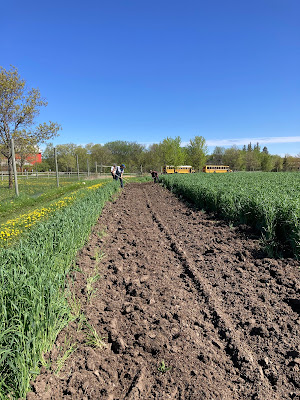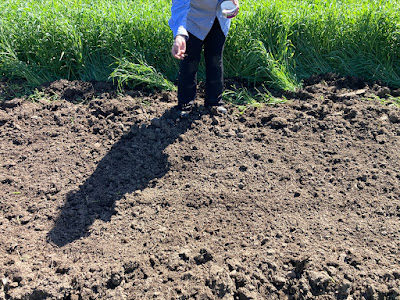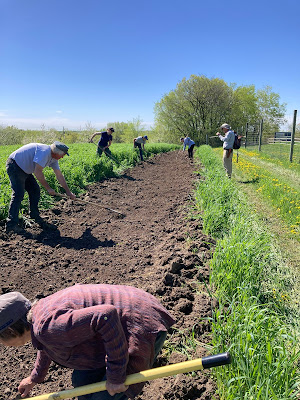Sowing Linen Flax Adventures in 2024!
I am not very consistent with this blog. I can't believe over a year has passed since I put something up here.
A lot has been happening with me and linen flax since I received the American Swedish Institute Teaching Tools Grant for acquiring (and creating) linen flax processing tools. I've had three sold-out flax processing workshops at the ASI over the past year, one sold-out flax spinning class at ASI, demonstrated flax processing at the ASI midsummer event, presented on the subject of linen flax to the Minnesota Landscape Arboretum, and gave a presentation and demonstration on linen flax to nearly 80 attendees at the Weavers' Guild of Minnesota. Whew! That, plus more research into the historical and biological aspects of linen flax, has kept me busy and given me more knowledge of the subject to the point that I wanted to dig deeper this year, literally deeper, into linen flax.
So, last fall, I purchased more linen flax seeds from the Landis Valley Heritage Museum in Pennsylvania. Receiving this pound of seed (Avian variety) put urgency into me to find a place to grow the seed in the spring of 2024. Nothing like finding something to kick you in the butt!
In the past, I taught and volunteered in the fiber program at Gale Woods Farm, an educational farm part of the Three Rivers Park District in Minnesota. In the winter, I approached the farm staff to see if I could kick-start a linen flax crop this spring. When they saw the possibilities of this fitting into their sustainability programming, it was a “Yeah! Let's do it!"
I also wanted to have a personal plot with part of the seed I purchased to record the entire growing process daily. Therefore, between the two growing projects for this summer, my refresh of the Saga Hill blog begins as a way to record this year of linen flax!
My personal home plot begins
To respect nature's calendar year, I looked at the Bloodroot plant that grows in our home woods. Its blooming is always a sign that true spring has arrived. Even if the weather might get cold and even snow, which it did, I have never seen any major cold events happen after the Bloodroot blooms. This year, it bloomed a good two weeks before prior years. So, I used that as my guide for sowing my linen seeds. Onward!
The technical details of my home plot…
Plot size: somewhat triangular, roughly 6 x 7 (42 square feet).
Date sown: 4/15/24. This date was chosen because the Bloodroot in the nearby wooded area is now in bloom, which has been an early sign of true spring here. (This is about two weeks before its bloom date in previous years.)
Time sown: 4 PM
Weather: 66 degrees, partly cloudy, rain in the forecast
Soil temp: did not test, although nearby farm had a soil temp of 40 degrees nearly 2 weeks ago. According to University studies, 40–50 degrees is supposedly the ideal temperature for flax sowing (although that may be for seed and straw flax).
Soil: Loamy, raked up 3x to a fine consistency
Sown: 4 ounces
Sowing method: Broadcasting from a cup. Criss-crossed plot to densely cover the entire area. Then stepped down and watered. Some seeds remained on the surface. Reworked soil with a fine rake so more seeds would drop into the soil.
I placed a wooden grid and some sticks over the plot to try to keep the dog and some critters out. Keeping ground squirrels out will probably be my biggest challenge.
For the following 48 hours, there was a LOT of rain, and the north part of the bed was flooded. I will wait to see if any seeds germinate before re-seeding it in that area.
From 4/15 to 4/25, some nights had 33-degree temperatures, perhaps briefly below freezing, too. There has been considerable rain during this period. I only needed to water the plot once around 4/23.
4/26/24 – (12 days since sowing) The first sign of emerging plants! I put sticks over the plot to discourage our dog and other critters from stepping on the area.
4/30/24 – It appears that most of the seeds have germinated. The partial flooding of the plot and the early cold weather don’t seem to have affected the germination in any obvious way. The north end of the plot is more prolific than the south end. That may be because, right now, the north end gets a little more sun. The sun exposure for the entire plot will increase up to midsummer. Interestingly, it took longer for the seeds to germinate than those I have sown during warmer weather in previous years (particularly on the 20th of May, 2023). The photo below shows that more seeds have germinated from the initial emergence. I removed the sticks and now have a fence around the plot.

5/8/24 – (4th week since sowing—the date of this blog post) The seeds have grown to a height of about 1 inch in general. Since the 30th of April, there has been rain nearly every other day, so I have not had to water the plot yet. The sun is more centralized over the plot, although the nearby trees are also leafing out, leading to a shorter amount of direct sun in the course of a day. Our property has so many trees, which is another reason I sought out Gale Woods Farm as another plot test. So far, weed growth is minimal.
The Gale Woods plot begins
May 8, 2024 – we sowed 1.5 pounds of linen flax seeds at Gale Woods Farm this morning!
The garden supervisor managed to corral three staff and one volunteer to help with the sowing. Approximately 150 linear feet of linen flax (Avian variety) was sown by 11 AM on this gorgeous spring day, with an air temperature of around 65 degrees and a very light breeze. Between the six of us, it only took about 45 minutes to finish the job: from raking the soil to a finer consistency (“as fine as snuff,” as the Swedes say), distributing and broadcasting the seeds with our hands from cups, and raking the seeds into the soil. Efficiency comes in numbers! Now we wait for a potential rain this evening, or the garden supervisor will sprinkle a little water on the seed bed tomorrow morning. It was interesting to see the seeds shining in the sun before the final raking, knowing that more raking was needed if we saw any seeds shining. Crossing my fingers that we see the plants emerging in about a week!
Here are some images from the Gale Woods sowing:
The initial raking of the plot row. The plot is 4 feet wide with 2 feet on either side for walking.
We distributed the seeds into cups to broadcast them evenly in the plot row.
The seeds were broadcast (thrown) onto the plot row. To ensure the seeds were consistently sown along the row, each person had four ounces of seeds to spread within their zone. Linen flax requires a tight density of plants—as many as 2000 seeds per square yard!
The final step was to rake the seeds into the plot row. The seeds only need to be sown about 1/2 to 1 inch into the soil, and a gentle raking is a very efficient method of achieving this.









